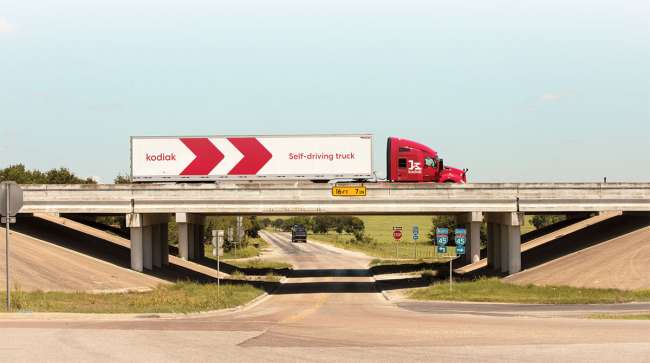Managing Editor, Features and Multimedia
Autonomous Truck Developers Must Address Technical Concerns

[Stay on top of transportation news: Get TTNews in your inbox.]
ORLANDO, Fla. — Autonomous truck developers are making steady progress toward commercialization, but these companies and their future fleet customers will need to address a variety of technical issues and other operational concerns to integrate this technology into the freight transportation industry.
For example, autonomous trucks must be able to smoothly interact with law enforcement and connect with smart trailers to pave the way for deployment, autonomous vehicle experts said April 25 at the inaugural Automated Goods Movement Summit hosted by the Association for Unmanned Vehicle Systems International.
One key topic was the development of law enforcement interaction plans for autonomous trucks.

Fabbri
If an unmanned truck becomes disabled, is involved in an accident or pulls over for a traffic stop, law enforcement officers must have a clear understanding of how to interact with that vehicle and who to contact if there is no one inside.
If the officer is unsure how to deal with the situation, “we have not done our job,” said Brett Fabbri, head of law enforcement policy and highway safety at self-driving truck developer Kodiak Robotics.
To address this issue, Kodiak is partnering with law enforcement to build trust and bring clarity to those interactions.
“It is paramount that we have a working relationship with law enforcement,” Fabbri said. “We cannot do this without partnering with law enforcement.”
Kodiak also is focusing on minimizing the time that officers would need to spend roadside during a traffic stop — an inherently dangerous part of their jobs.
Chris Kinn, a staff lieutenant with the Ohio Highway Patrol, emphasized the need for clear interaction plans as autonomous vehicles make their way onto roadways. That includes the ability to contact appropriate personnel around the clock if an unmanned vehicle is stopped or disabled.
“All these things are so important to us as we’re interacting with these vehicles,” Kinn said. “It’s so much different than anything we’ve ever done before in law enforcement.”
Another technical issue raised at the event was the need to integrate connected trailers into autonomous truck operations.
“You can’t couple a dumb trailer with a smart tractor and think things are going to work out properly,” said Andy Alden, a senior research associate at the Virginia Tech Transportation Institute.
Developers also will need to earn public acceptance and address questions about the future of the industry’s workforce.
Lisa Whalen, head automotive analyst at Morning Consult, said the autonomous vehicle industry has an “uphill battle” to change public perceptions about the technology.
She said her firm has found that only 19% of consumers at this point feel that autonomous vehicles are safer than traditional vehicles — a figure that has eroded over the past four years from about 27%.
Kodiak’s Fabbri said safety is paramount for autonomous trucking.
“We have to get this right,” he said. “If we don’t — if we make a mistake, if we cut a corner — we can set the industry back decades.”
Autonomous truck developers described their technology as a complement to the industry’s workforce rather than a potential threat to jobs.
Want more news? Listen to today's daily briefing above or go here for more info
“If you’re a trucker entering into industry for the first time now, you’ll be able to retire as a truck driver if you want to retire as a truck driver,” said Wiley Deck, vice president of government affairs and public policy at Plus.
Automation could even make those jobs better, said Lee White, vice president of strategy at TuSimple.
The drivers entering the industry today generally don’t want to be away from home for weeks at a time, he said. “They want to be home every night. They want to coach sports teams. They want to attend concerts.”
Autonomous trucks will complement trucking companies’ existing fleets and give them a pathway to provide the work-life balance that their drivers are seeking, White said.



